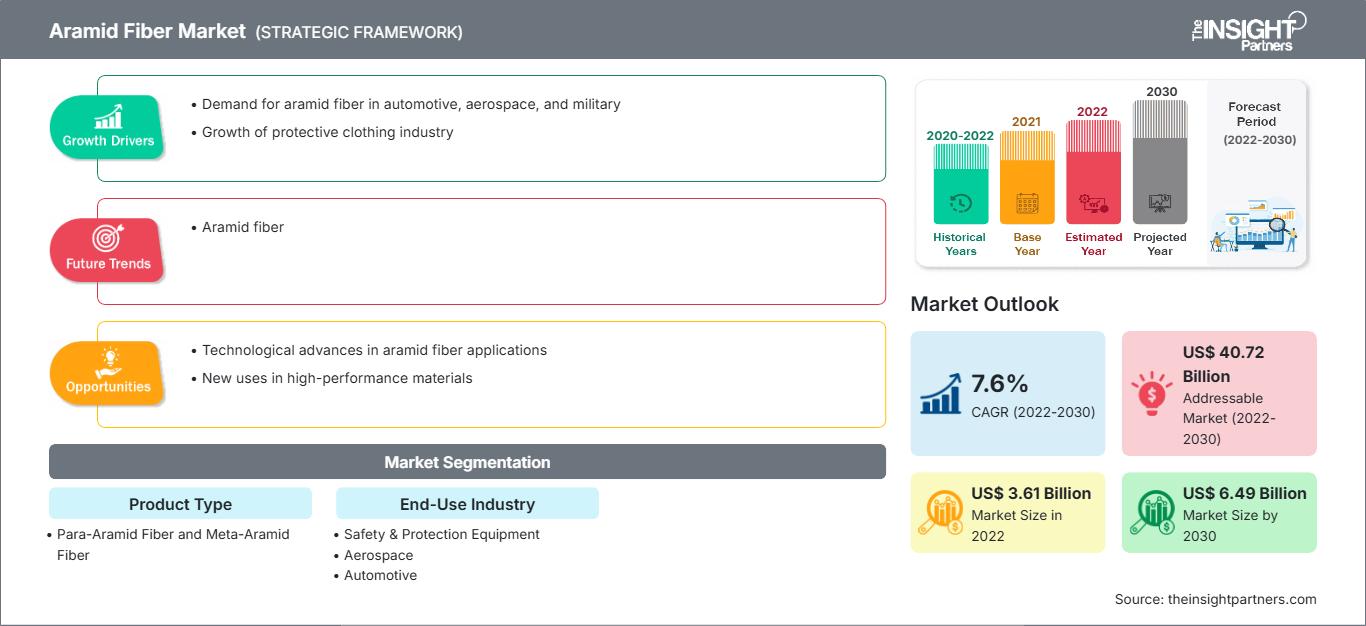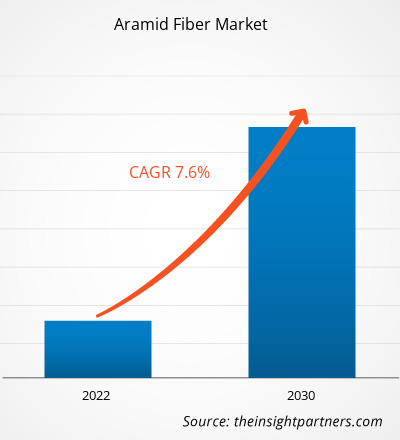[Rapport de recherche] Le marché des fibres aramides était évalué à 3,61 milliards de dollars américains en 2022 et devrait atteindre 6,49 milliards de dollars américains d'ici 2030 ; on estime qu'il enregistrera un TCAC de 7,6 % de 2022 à 2030.
Analyses du marché et point de vue des analystes :
Les fibres aramides, également appelées polyamides aromatiques, sont des fibres synthétiques dotées d'une résistance, d'une résistance à la chaleur et d'une durabilité exceptionnelles. Elles sont réputées pour leur résistance à la traction élevée, cinq à six fois supérieure à celle de l'acier, et leur légèreté, ne pesant qu'un cinquième du poids de l'acier. Ces propriétés remarquables rendent ces fibres précieuses pour un large éventail d'applications, en particulier dans les industries qui exigent des performances et une sécurité élevées. La structure unique des fibres aramides contribue de manière significative à leurs propriétés exceptionnelles. Ces fibres sont constituées de longues chaînes de molécules de polyamide, où les liaisons amides sont directement liées à des cycles aromatiques. Cet agencement donne une structure rigide en forme de tige qui confère aux fibres une résistance et une rigidité remarquables. De plus, les cycles aromatiques offrent une résistance à la chaleur et une stabilité inhérentes, permettant à ces fibres de supporter des températures élevées sans dégradation significative.
Moteurs de croissance et défis :
La demande croissante de l'industrie automobile a été un moteur majeur de l'expansion du marché des fibres aramides. La demande pour ces fibres a augmenté de manière exponentielle, les constructeurs automobiles se concentrant de plus en plus sur la production de véhicules plus légers et plus économes en carburant. Le rapport résistance/poids élevé de ces fibres, en particulier des variantes para-aramides, dont le Kevlar, permet le développement de composants légers sans compromettre l'intégrité structurelle. Dans le secteur automobile, ces fibres sont largement utilisées dans diverses applications, notamment la fabrication de pneus, de freins, de plaquettes et de matériaux composites. Le renforcement de ces composants avec ces fibres améliore leur durabilité et leur résistance à l'usure, contribuant ainsi à une durée de vie plus longue et à de meilleures performances globales. De plus, ces fibres sont utilisées dans la production de composites automobiles, offrant un équilibre entre résistance et poids essentiel pour atteindre les objectifs d'efficacité énergétique. Ainsi, tous ces facteurs stimulent la demande de fibres d'aramide dans le secteur automobile.
Cependant, le marché des fibres d'aramide est confronté à une croissance limitée en raison de la disponibilité de substituts offrant des propriétés similaires ou alternatives. La fibre de carbone est l'un des principaux substituts de ces fibres, partageant certaines caractéristiques avec les fibres d'aramide, notamment une résistance élevée et une légèreté accrue. Dans certaines applications, les fabricants peuvent opter pour la fibre de carbone comme alternative, notamment lorsqu'ils recherchent des matériaux offrant une rigidité ou une conductivité supérieures. Cette concurrence des substituts constitue un défi pour l'adoption généralisée de ces fibres, en particulier dans les industries où les deux matériaux pourraient potentiellement répondre aux spécifications requises.
Personnalisez ce rapport en fonction de vos besoins
Vous bénéficierez d’une personnalisation sur n’importe quel rapport - gratuitement - y compris des parties de ce rapport, ou une analyse au niveau du pays, un pack de données Excel, ainsi que de profiter d’offres exceptionnelles et de réductions pour les start-ups et les universités
Marché de la fibre d'aramide: Perspectives stratégiques

- Obtenez les principales tendances clés du marché de ce rapport.Cet échantillon GRATUIT comprendra une analyse de données, allant des tendances du marché aux estimations et prévisions.
Vous bénéficierez d’une personnalisation sur n’importe quel rapport - gratuitement - y compris des parties de ce rapport, ou une analyse au niveau du pays, un pack de données Excel, ainsi que de profiter d’offres exceptionnelles et de réductions pour les start-ups et les universités
Marché de la fibre d'aramide: Perspectives stratégiques

- Obtenez les principales tendances clés du marché de ce rapport.Cet échantillon GRATUIT comprendra une analyse de données, allant des tendances du marché aux estimations et prévisions.
Segmentation et portée du rapport :
L'analyse du marché mondial de la fibre aramide à l'horizon 2030 est une étude spécialisée et approfondie axée sur les tendances et les opportunités de croissance du marché à l'échelle mondiale. Ce rapport vise à fournir un aperçu du marché avec une segmentation détaillée par type de produit et par secteur d'utilisation finale. Le marché a connu une forte croissance ces dernières années et devrait poursuivre cette tendance au cours de la période de prévision. Le rapport fournit des statistiques clés sur la consommation de fibre aramide à l'échelle mondiale. Il fournit également une évaluation qualitative des différents facteurs affectant la performance du marché mondial de la fibre aramide. Il comprend également une analyse complète des principaux acteurs du marché et de leurs principaux développements stratégiques. Plusieurs analyses de la dynamique du marché sont également incluses pour aider à identifier les principaux facteurs moteurs, les tendances du marché et les opportunités lucratives qui, à leur tour, aideraient à identifier les principales poches de revenus.
L'analyse de l'écosystème et l'analyse des cinq forces de Porter fournissent une vue à 360 degrés du marché, ce qui permet de comprendre l'ensemble de la chaîne d'approvisionnement et les différents facteurs affectant la croissance du marché mondial de la fibre aramide.
Analyse segmentaire :
Sur la base du type de produit, le marché est divisé en fibres para-aramides et fibres méta-aramides. En termes d'industrie d'utilisation finale, le marché est segmenté en équipements de sécurité et de protection, aérospatiale, automobile, électronique et télécommunications, et autres. Le marché de la sécurité et Le segment des équipements de protection a enregistré une part de marché significative de la fibre aramide en 2022. Les fibres aramides, en particulier les variantes para-aramides comme le Kevlar, sont réputées pour leur résistance exceptionnelle, leur module élevé et leur résistance aux chocs, ce qui les rend idéales pour les applications où la sécurité et la protection sont primordiales. Cette fibre est largement utilisée dans la fabrication de gilets et de casques balistiques. La résistance balistique inhérente de ces fibres, associée à leur légèreté, en fait un choix privilégié pour les gilets pare-balles. Les forces armées et les forces de l'ordre du monde entier utilisent largement les équipements de protection à base d'aramide pour offrir au personnel une protection efficace contre les menaces balistiques sans compromettre la mobilité. Tous ces facteurs stimulent le marché de la fibre aramide pour le segment des équipements de sécurité et de protection.
Analyse régionale :
Sur le plan géographique, le marché de la fibre aramide est segmenté en cinq régions clés : Amérique du Nord, Europe, Asie-Pacifique, Amérique du Sud et centrale, et Moyen-Orient et Afrique. Le marché était dominé par l'Asie-Pacifique, qui représentait environ 1 milliard de dollars américains en 2022. La région offre de nombreuses opportunités de croissance pour le marché. L'augmentation des investissements directs étrangers contribue également à la croissance économique de la région. L'utilisation croissante de ces fibres dans de nombreuses applications, notamment les pièces automobiles, l'électronique et autres, devrait accroître la demande de fibres aramides en Asie-Pacifique. L'Europe devrait enregistrer un TCAC de plus de 8,0 % entre 2022 et 2030. Les fibres aramides sont essentielles à la fabrication de composants légers mais robustes dans les structures aéronautiques et les systèmes de protection balistique. L'Europe abritant des entreprises aérospatiales de premier plan et un secteur de la défense important, la demande de fibres aramides dans ces industries continue de croître. De plus, l'Amérique du Nord devrait atteindre environ 1,7 milliard de dollars américains en 2030.
Développements du secteur et opportunités futures :
Diverses initiatives prises par les principaux acteurs du marché de la fibre aramide sont énumérées ci-dessous :
- En avril 2023, DuPont de Nemours Inc. a annoncé le lancement de la fibre aramide Kevlar EXOTM. Kevlar EXO offrira une combinaison de légèreté, de flexibilité et de protection grâce à la fibre aramide, la protection des personnes étant le premier de nombreux cas d'utilisation.
Aperçu régional du marché des fibres d'aramide
Les tendances régionales et les facteurs influençant le marché de la fibre aramide tout au long de la période de prévision ont été analysés en détail par les analystes de The Insight Partners. Cette section aborde également les segments et la géographie du marché de la fibre aramide en Amérique du Nord, en Europe, en Asie-Pacifique, au Moyen-Orient et en Afrique, ainsi qu'en Amérique du Sud et en Amérique centrale.
Portée du rapport sur le marché des fibres d'aramide
| Attribut de rapport | Détails |
|---|---|
| Taille du marché en 2022 | US$ 3.61 Billion |
| Taille du marché par 2030 | US$ 6.49 Billion |
| TCAC mondial (2022 - 2030) | 7.6% |
| Données historiques | 2020-2022 |
| Période de prévision | 2022-2030 |
| Segments couverts |
By Type de produit
|
| Régions et pays couverts | Amérique du Nord
|
| Leaders du marché et profils d'entreprises clés |
|
Densité des acteurs du marché de la fibre aramide : comprendre son impact sur la dynamique commerciale
Le marché de la fibre aramide connaît une croissance rapide, portée par une demande croissante des utilisateurs finaux, due à des facteurs tels que l'évolution des préférences des consommateurs, les avancées technologiques et une meilleure connaissance des avantages du produit. Face à cette demande croissante, les entreprises élargissent leur offre, innovent pour répondre aux besoins des consommateurs et capitalisent sur les nouvelles tendances, ce qui alimente la croissance du marché.

- Obtenez le Marché de la fibre d'aramide Aperçu des principaux acteurs clés
- Analyse historique (2 ans), année de base, prévision (7 ans) avec TCAC
- Analyse PEST et SWOT
- Taille du marché Valeur / Volume - Mondial, Régional, Pays
- Industrie et paysage concurrentiel
- Ensemble de données Excel
Rapports récents
Rapports connexes
Témoignages
Raison d'acheter
- Prise de décision éclairée
- Compréhension de la dynamique du marché
- Analyse concurrentielle
- Connaissances clients
- Prévisions de marché
- Atténuation des risques
- Planification stratégique
- Justification des investissements
- Identification des marchés émergents
- Amélioration des stratégies marketing
- Amélioration de l'efficacité opérationnelle
- Alignement sur les tendances réglementaires




















 Obtenez un échantillon gratuit pour - Marché de la fibre d'aramide
Obtenez un échantillon gratuit pour - Marché de la fibre d'aramide